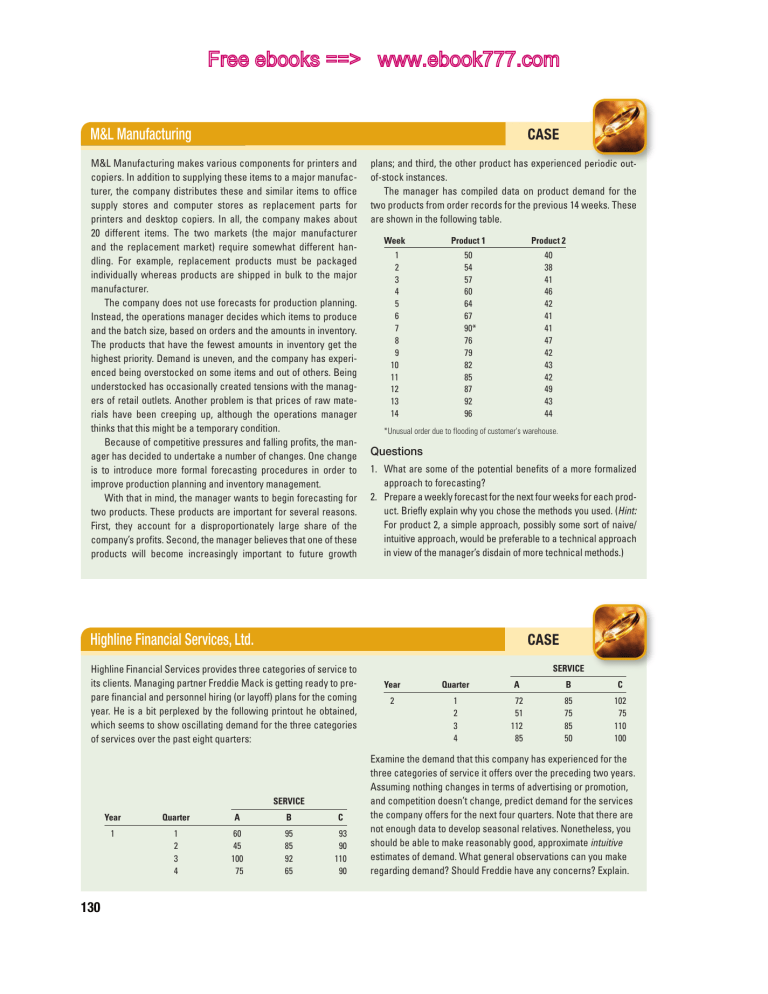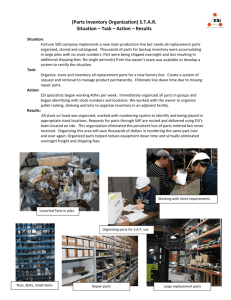
Free ebooks ==> www.ebook777.com M&L Manufacturing CASE M&L Manufacturing makes various components for printers and copiers. In addition to supplying these items to a major manufacturer, the company distributes these and similar items to office supply stores and computer stores as replacement parts for printers and desktop copiers. In all, the company makes about 20 different items. The two markets (the major manufacturer and the replacement market) require somewhat different handling. For example, replacement products must be packaged individually whereas products are shipped in bulk to the major manufacturer. The company does not use forecasts for production planning. Instead, the operations manager decides which items to produce and the batch size, based on orders and the amounts in inventory. The products that have the fewest amounts in inventory get the highest priority. Demand is uneven, and the company has experienced being overstocked on some items and out of others. Being understocked has occasionally created tensions with the managers of retail outlets. Another problem is that prices of raw materials have been creeping up, although the operations manager thinks that this might be a temporary condition. Because of competitive pressures and falling profits, the manager has decided to undertake a number of changes. One change is to introduce more formal forecasting procedures in order to improve production planning and inventory management. With that in mind, the manager wants to begin forecasting for two products. These products are important for several reasons. First, they account for a disproportionately large share of the company’s profits. Second, the manager believes that one of these products will become increasingly important to future growth plans; and third, the other product has experienced periodic outof-stock instances. The manager has compiled data on product demand for the two products from order records for the previous 14 weeks. These are shown in the following table. Week Product 1 Product 2 1 2 3 4 5 6 7 8 9 10 11 12 13 14 50 54 57 60 64 67 90* 76 79 82 85 87 92 96 40 38 41 46 42 41 41 47 42 43 42 49 43 44 *Unusual order due to flooding of customer's warehouse. Questions 1. What are some of the potential benefits of a more formalized approach to forecasting? 2. Prepare a weekly forecast for the next four weeks for each product. Briefly explain why you chose the methods you used. (Hint: For product 2, a simple approach, possibly some sort of naive/ intuitive approach, would be preferable to a technical approach in view of the manager’s disdain of more technical methods.) Highline Financial Services, Ltd. CASE Highline Financial Services provides three categories of service to its clients. Managing partner Freddie Mack is getting ready to prepare financial and personnel hiring (or layoff) plans for the coming year. He is a bit perplexed by the following printout he obtained, which seems to show oscillating demand for the three categories of services over the past eight quarters: SERVICE 130 Year Quarter A B C 1 1 2 3 4 60 45 100 75 95 85 92 65 93 90 110 90 SERVICE Year Quarter A B C 2 1 2 3 4 72 51 112 85 85 75 85 50 102 75 110 100 Examine the demand that this company has experienced for the three categories of service it offers over the preceding two years. Assuming nothing changes in terms of advertising or promotion, and competition doesn’t change, predict demand for the services the company offers for the next four quarters. Note that there are not enough data to develop seasonal relatives. Nonetheless, you should be able to make reasonably good, approximate intuitive estimates of demand. What general observations can you make regarding demand? Should Freddie have any concerns? Explain.



